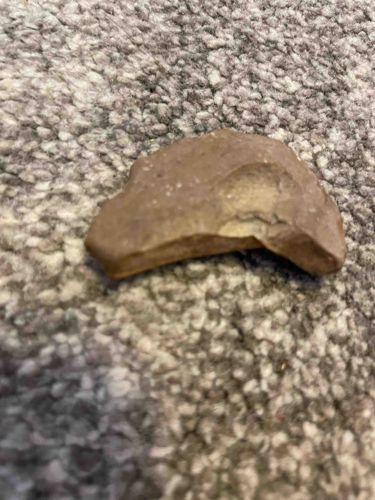
Prehistoric Stone Tool Fragment (Scraper/Flake)
The item appears to be an ancient stone tool, possibly a scraper or a portion of a larger lithic implement, crafted from a fine-grained, sedimentary rock, potentially chert or flint, given its conchoidal fracture pattern and the way light reflects off its surfaces. Its color is a muted, earthy brown or light gray-brown, with subtle variations in tone. The overall shape is irregular, roughly crescent-like, with one edge exhibiting a deliberate, finely flaked curvature, indicative of a working edge. The opposite side appears to be a natural break or a core remnant. The tool measures approximately a few inches across, consistent with a handheld implement. There are visible signs of wear and patina, suggesting prolonged exposure to the elements and/or use. Small white specks or inclusions are scattered across its surface, which could be natural mineral inclusions within the rock or part of its weathering process. The craftsmanship, though simple, shows clear evidence of knapping – the controlled fracturing of stone to create a desired shape and edge. No discernable maker's marks or modern alterations are visible, reinforcing its likely ancient origin. Its condition indicates it is an unearthed artifact, possibly showing some natural erosion but no obvious recent damage or repairs. The quality of the knapping points to a functional tool made by skilled hands, consistent with stone age technologies.
AI-Generated Appraisal Disclaimer
Estimated Value
$75 - $125
Basic Information
Category
Archaeological Artifact/Tool
Appraised On
November 29, 2025
Estimated Value
$75 - $125
Item Description
The item appears to be an ancient stone tool, possibly a scraper or a portion of a larger lithic implement, crafted from a fine-grained, sedimentary rock, potentially chert or flint, given its conchoidal fracture pattern and the way light reflects off its surfaces. Its color is a muted, earthy brown or light gray-brown, with subtle variations in tone. The overall shape is irregular, roughly crescent-like, with one edge exhibiting a deliberate, finely flaked curvature, indicative of a working edge. The opposite side appears to be a natural break or a core remnant. The tool measures approximately a few inches across, consistent with a handheld implement. There are visible signs of wear and patina, suggesting prolonged exposure to the elements and/or use. Small white specks or inclusions are scattered across its surface, which could be natural mineral inclusions within the rock or part of its weathering process. The craftsmanship, though simple, shows clear evidence of knapping – the controlled fracturing of stone to create a desired shape and edge. No discernable maker's marks or modern alterations are visible, reinforcing its likely ancient origin. Its condition indicates it is an unearthed artifact, possibly showing some natural erosion but no obvious recent damage or repairs. The quality of the knapping points to a functional tool made by skilled hands, consistent with stone age technologies.
Get Your Items Appraised
Instant estimates of your treasures with AI-powered instant appraisals